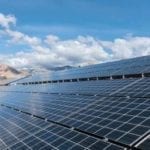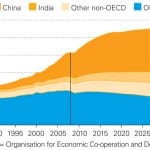Driven by the booming growth of generation from hydro, wind, and solar photovoltaics (PV), generation from renewables on a terawatt-hour basis is set to surpass that from natural gas and double nuclear’s share by 2016, becoming the world’s second-most important global electricity source after coal, according to a new report from the International Energy Agency (IEA).
The IEA forecasts in its second annual Medium-Term Renewable Energy Market Report (MTRMR) released on Wednesday that renewable electricity growth will soar over the next five years, jumping nearly 40% from 4,860 TWh in 2012 to 6,850 TWh in 2018—a growth of about 6% per year. Globally, renewable generation is estimated to rise to 25% of gross power generation in 2018, up from 20% in 2011 and 19% in 2006. Total renewable capacity, meanwhile, could grow from 1,580 GW in 2012 to 2,350 GW in 2018.
Last week, in a separate report analyzing natural gas’ share of the global energy mix over the next five years , the IEA forecast global growth in natural gas use slowed in 2012 on continued weak demand in Europe, resilience of coal in North America, and persistent bottlenecks and disruptions in the liquefied natural gas value chain. Demand for natural gas will continue to grow over the next five years, driven by its emerging use as a transportation fuel, but the IEA expects growth of natural gas in power generation to slow over the same period.
However, the future for renewables isn’t all rosy, the IEA says. New investments in renewables have fallen as incentives have been reduced in an age of austerity while policy uncertainties continue "to cloud the investment outlook for some key markets," it says. At the same time, some regions are facing integration challenges from higher penetrations of variable renewables. Competition from other energy sources have also hindered growth, as with the shale gas expansion in the U.S., for example. And, manufacturing industries for renewables—particularly solar PV and wind—have entered a "more intense period of restructuring and consolidation," the IEA says.
Yet the share of non-hydro renewable power (which includes biomass, wind, solar PV, solar thermal electricity from concentrating solar power plants, geothermal, and ocean power) is forecast to double, to 8% of gross generation in 2018, up from 4% in 2011 and 2% in 2006, the report says.
In developed countries (members of the Organisation for Economic Co-operation and Development [OECD]), non-hydro renewable power will rise to 11% of gross generation by 2018, up from 7% in 2012, the report says. Non-OECD countries will account for two-thirds of global renewable generation growth between 2012 and 2018, and more than 50% of the non-hydro portion. China, in particular, will lead the charge with mass additions of hydro and wind capacity, and it is expected to account for 40% (or 310 GW) of the world’s new renewable capacity over that period.
Onshore wind, in particular, is expected to be deployed in almost 75 countries by 2018. Deployment of solar PV at the 100-MW level should be reached in 65 countries by 2018, up from 30 in 2012, and of biomass at that level in more than 50 countries by 2018, up from 40 in 2012. "The spread of offshore wind, CSP, geothermal and ocean deployment should remain relatively slower, however," the IEA notes.
Among trends highlighted by the agency is that hydropower and geothermal in areas with good resources are generally competitive with new fossil-fuelled power plants. Large-scale biomass plants are also competitive, depending on feedstock prices and availability. "Levelised costs for other renewables generally remain higher than new fossil fuel generation; as such, these sources often require policy support to remain economically attractive. Yet the most dynamic technologies—onshore wind and solar PV—have reached, or are approaching, competitiveness in a number of markets without generation-based incentives," the IEA says.
In Brazil, for example, the levelized cost of electricity (LCOE) for onshore wind is competitive with new natural gas power plants—as well as with hydropower and biomass. In Australia, which recently implemented a carbon trading program, wind is competitive with generation costs of new coal- and gas-fired plants. And with long-term power purchase agreements (PPAs), onshore wind costs are approaching those of new coal-fired plants in South Africa, the IEA says. Meanwhile, in Chile and Mexico, onshore wind competes—or is close to competing—with new gas-fired plants. Onshore wind remains more expensive than new gas-fired generation in the U.S., but the IEA suggests that "long-term PPAs for wind power can provide cost-effective hedges against rising fuel prices over the long term, even without federal tax incentives."
Solar PV, too, is seeing an emerging competitiveness. "Emerging competitive segments are linked to the concept of grid or ‘socket’ parity—when the LCOE of decentralised solar PV systems becomes lower than retail electricity prices that system owners would otherwise pay. Such markets are appearing in Spain, Italy, southern Germany, southern California, Australia and Denmark, and across residential and commercial segments."
Sources: POWERnews, POWER, IEA
—Sonal Patel, Senior Writer (@POWERmagazine, @sonalcpatel)










